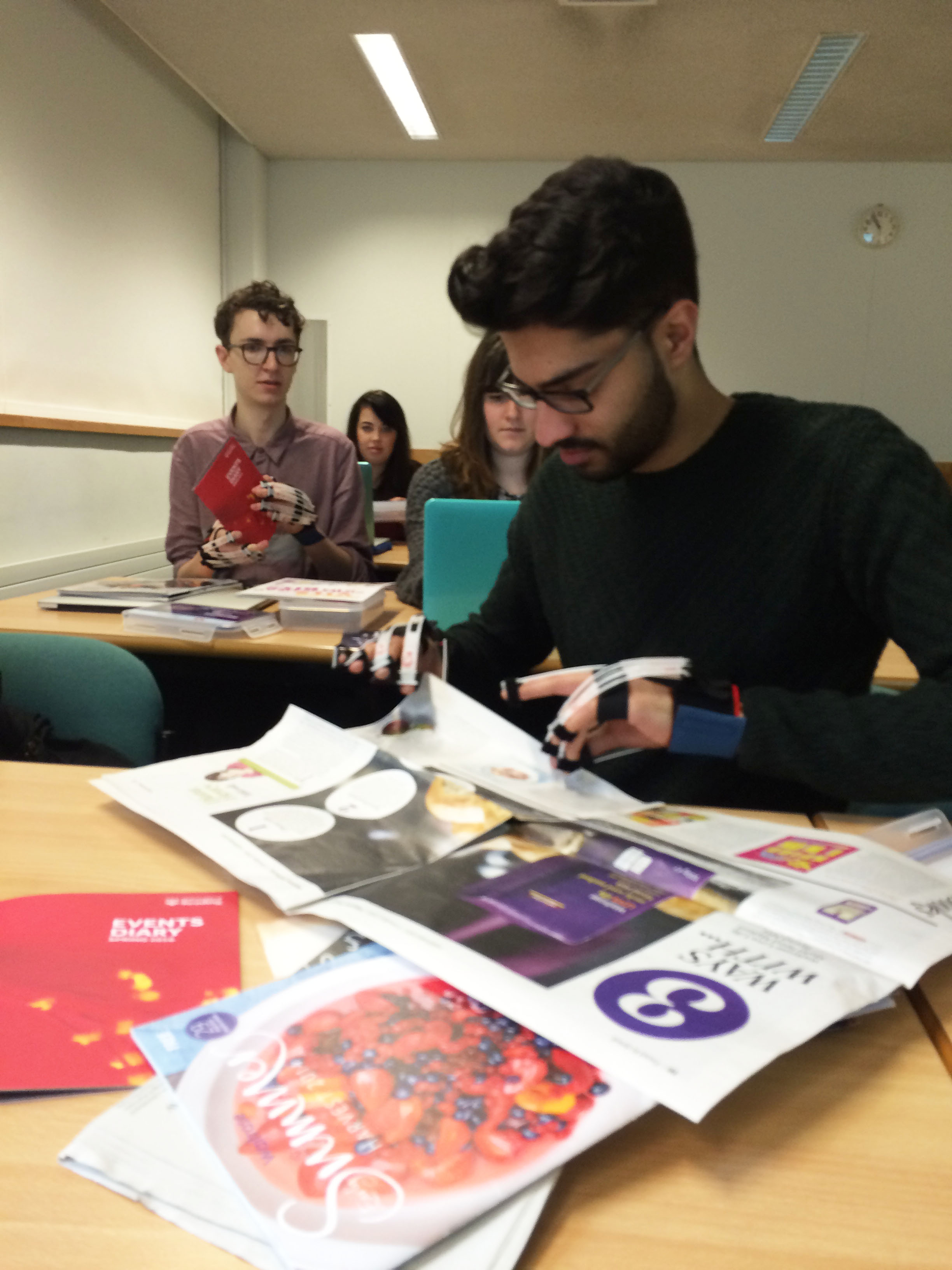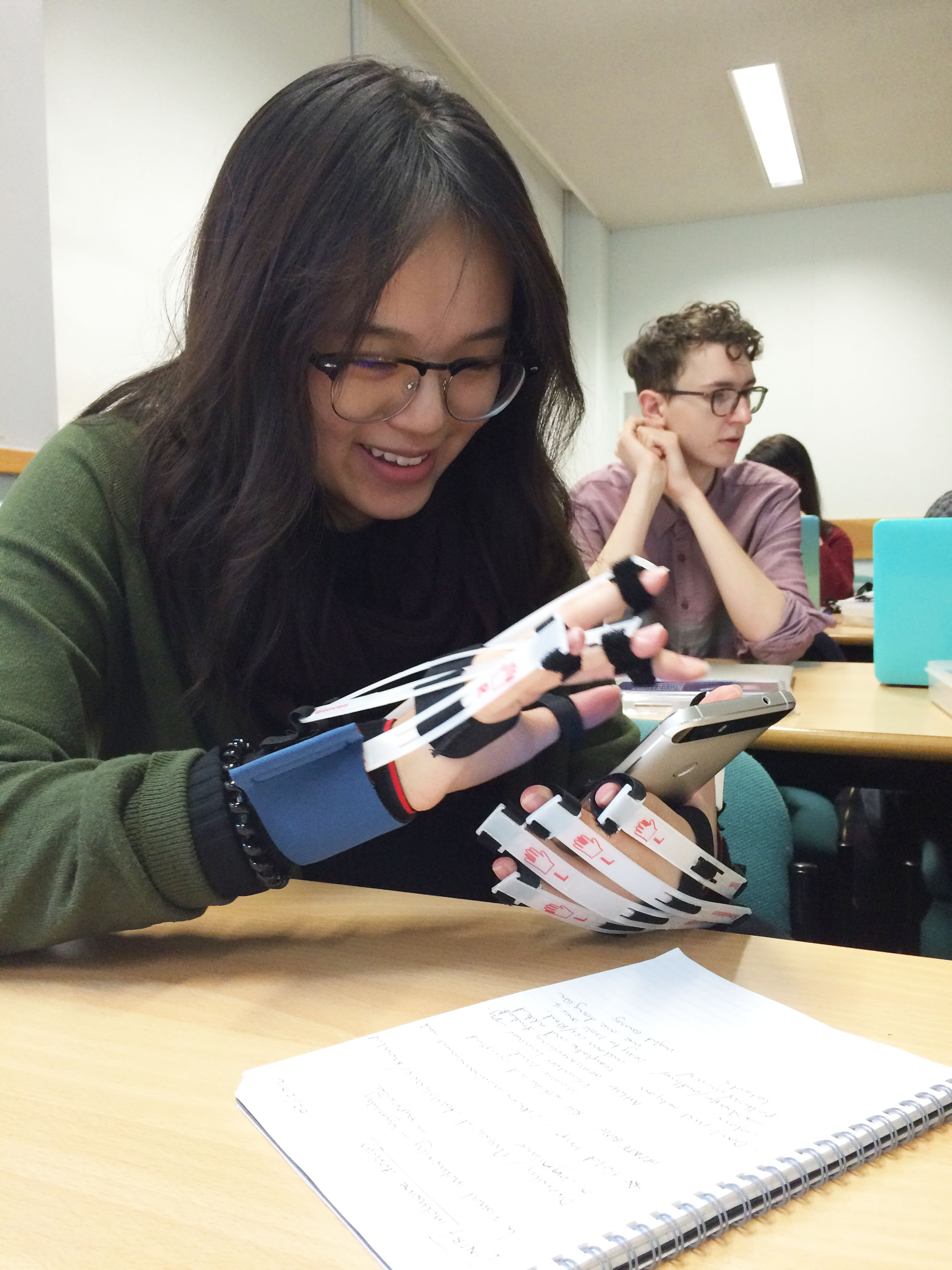This week, Part 2 Graphic Communication students completed the inclusive design component of their integrated design modules. Building on the series of workshops (see BdB blog) we did earlier in the term and relevant readings, on Monday, students presented seminar papers to their peers on particular aspects of inclusive design.
-

On Monday, our Graphic Communication students presented inclusive design seminars to their peers (from left to right): Jordan Bellinger, Lewis Burfield, Maciej Bykowski, Fenella Astley, Rajvir Bhogal, Stephanie Boateng, Cherise Booker, June Lin and (front) Jordan Cairns.
Students discussed and debated, aspects such as:
- The principles of inclusive design and how designers can make these achievable in real life projects
- How design briefs often tend to create segregation and how designers can develop more inclusive solutions to briefs
- The clear print debate – what the guidelines are, who they are for and how implementing these can differ for professional designers and everyday communicators
- The challenges and key considerations of inclusive design for screen – including the use of colour, images, sound and navigation
- Key debates and typographic research for inclusive design for children’s reading, focusing on readers who may have dyslexia or visual impairments
- Inclusive wayfinding – including challenges and innovative proposals for solutions in contemporary design practice.
Students commented that the inclusive design workshops, readings and seminars they have done have helped them become “more consciously aware” of how important it is to consider inclusive design in their own work and how designers may have to take responsibility for designing inclusively for a range of users. The highlighted how it is important to realise that the people they are designing for are probably “not the same as you (the designer)” and that inclusive design is “not just being aware” but about embedding inclusive practices in our industry. They also noted that these seminars had made them aware that there is “not enough research” about inclusive design within our discipline.
Breaking down Barriers wins CIOB award for innovation


Typography students use simulation tools to appraise whether information in everyday contexts are presented in visually inclusive ways
Breaking down Barriers (BdB) – our multidisciplinary inclusive design project – has received a Highly Commended Award for Innovation in Education and Training in the 2016 Chartered Institute of Building (CIOB) International Innovation & Research Awards Scheme.
BdB champions a unique cross-disciplinary initiative to embed inclusive design across the University. Our BdB vision is to ensure Reading graduates across all disciplines advocate inclusion in their professional practices and bring real benefits to the everyday lives of all users, particularly people with conditions related to ageing and/or cognitive and physical disabilities. In Typography, we are engaging with inclusive design across a range of professional design contexts, including digital, packaging, print and wayfinding applications.
Typography students say that our BdB workshops have helped them “gain insight as to how thoughtful design can influence other industries and how we as designers must work together with these other industries in order to make the lives of the people that need a helping hand that little bit easier”.
CIOB Innovation and Research Awards highlight the importance of innovation and research in raising performance levels, enhancing best practice and improving the quality of the built environment. The CIOB judges said: “This innovation in education is a practical, engaging and demonstrable way to bring to life a real social challenge with widespread value and application. The innovation shows a genuine commitment to invest in the UK’s building stock and educate the next generation of professionals to ensure the needs of all users of a facility are firmly met.”
BdB began as an exciting collaboration between the School of Built Environment, the Henley Business School and the School of Arts and Communication Design in 2015. Since then we have been joined by staff within the School of Biological Sciences and collaborated with the Centre for Staff Development and, most recently, the School of Psychology and Clinical Language Sciences, as well as external partners.
Irmi Wachendorff awarded competitive research studentship

Visiting lecturer Irmi Wachendorff
Congratulations to Visiting Lecturer, Irmi Wachendorff who has been awarded a studentship from the German Academic Scholarship Foundation. Irmi’s doctoral research at the University of Duisburg-Essen explores social positioning through typographic variation in linguistic landscapes.
Irmi has joined the Department for the spring term as a visiting lecturer from Folkwang University of Arts. Drawing on her extensive professional experience working in Germany, Switzerland and Australia, she is primarily working with our Part 2 students on practical projects while she is in Reading. She is also leading a new theme in the Design Thinking module: “Graphic design theory: Reflecting practice”.
Staff exchanges play a key role in knowledge exchange and we are pleased to have Irmi with us to share her cross-disciplinary expertise and professional experience. Welcome to the Deparment, Irmi, and congratulations on your achievement!
Gold and silver placements at Design Portfolio
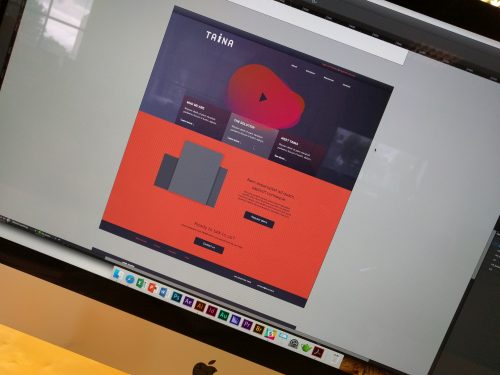
One of the digital projects Typography students Louise Lee and Sophie Rahier worked on during their placement at Design Portfolio. (image used with permission from Design Portfolio).
Part 3 students Louise Lee and Sophie Rahier completed an exciting placement at Design Portfolio’s Canary Wharf office during the summer vacation. Louise, Sophie and Anna Scully were the gold, silver and bronze winners of the 2016 Vince Ma Prize, which is awarded to the best performing students in Part 2, and includes a placement for gold and silver winners.
Louise and Sophie said the experience was “a real insight and great lesson on how projects are managed within a design agency”. They agreed it was an “enriching” experience for student designers.
During their placements, Louise and Sophie jobs undertook a range of design tasks, ranging from simple photo editing to website redesigns. The projects they worked on included branding, designing icons, and working with a range of material and deliverables. They also had an opportunity to apply their production knowledge since they were able to oversee a full design project being sent to print.
Louise and Sophie said: “The Design Portfolio team were very keen to have us involved, asking for our opinions as well as giving us the opportunity to attend client meetings. At these we presented our own work and had the chance to explain the rationale behind it. We were also given permission to share the work we were involved in and present them in our portfolios, as well as finishing off other briefs that we did not get to see through to the end.”
“Communicating with the rest of the Design Portfolio team (not just the designers) was highly important and added a new dimension to the design work. Whether it was with clients, marketing, or production, it was great to collaborate while still maintaining a certain freedom as designer, which is something that can’t easily be experienced through coursework.”
“Overall, working at Design Portfolio was invaluable experience, and taught us a lot. We’ve realised that even within a corporate design agency, the diversity in their jobs and clients provides an abundance of new and interesting challenges to a designer, which definitely builds versatility. Although we did not imagine a placement to be so enriching, we can now see why they are encouraged since the end of first year, and would in turn definitely recommend applying for one even if you are not 100% sure of what area of design you would like to pursue.”
They added: “It was also great to learn new life-saving keyboard shortcuts in which we cannot wait to share with our fellow coursemates!”
Minister for disabled people visits Reading
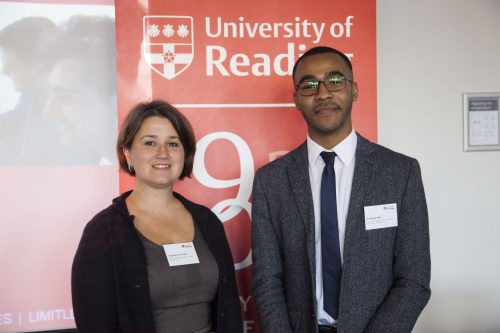
Dr Jeanne-Louise Moys with graduate Ryzard Akita following their presentations to the Minister
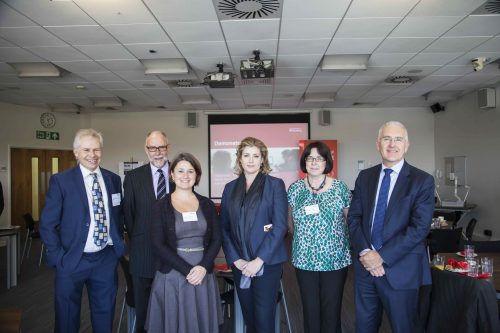
Penny Mordaunt, MP visited the University to meet our Breaking down Barriers team.
Yesterday, Penny Mordaunt, Minister for Disabled People, Health and Work visited the University of Reading to find out more about our transformative Breaking down Barriers (BdB) project.
BdB focuses on embedding inclusive design in our curricula across the University. Typography have been highly involved in the project from its inception and were proud to present the ways in which we are engaging with inclusive design across a range of applications including digital, print and wayfinding design.
In particular, we were pleased to welcome Ryzard Akita, one of our 2016 graduates who is now working as a user experience designer, back to Reading. Ryzard presented his final year self-directed project – an innovative mobile app for visually-impaired users – to the Minister. Some of our recent MA and undergraduate dissertations on inclusive design were also on display for the event.
The Minister also engaged with some of the simulation tools we have been using in our courses to increase students’ awareness of the everyday challenges people face in terms of mobility, dexterity and visibility. She praised the project, saying: “Inclusivity and accessibility should be at the forefront of good design, and I’m delighted to see the University of Reading leading the way with their Breaking down Barriers scheme.”
Soapbox host one of our typography summer placements

Visiting student Gabriela Lyrio Assreuy (far right) joined design studio Soapbox for her summer placement. Gabriela is pictured here with Soapbox’s team of Reading alumni from our BA and MA programmes (from left to right): Žiga Kropivišek, Megan Weston, Francesca Romano and Rachel Bray. Photo: Cormac Bakewell
Our Part 2 visiting student, Gabriela Lyrio Assreuy is spending her summer enjoying a stimulating, two-month placement at Soapbox. The London-based studio specialises in design that ‘helps leading policy, research and advocacy organisations to communicate their ideas’ and is the home to a number of Typography alumni from our BA and MA programmes (see pic).
Gabriela says: ‘At Soapbox I’m having the opportunity to watch closely how a successful design studio is run and how to deal with real demands, clients and timelines. Besides that, I have been able to work alongside other designers in different sorts of projects mostly permeating print design, such as publication design, infographics, branding. From typesetting to creative design processes, I am putting my abilities to practice and gaining new valuable skills and knowledge that will be essential to build a successful career.’
Soapbox designer and MAID alumnus, Žiga Kropivšek commented: ‘Introducing new colleagues to the work process is always a struggle, that is why working with Gabriela has been such a delight. She was very quick to learn all the tricks and, coming from Reading, we knew she would have a sharp eye for typographic detail. It has been very valuable for our company that we could entrust her with more complex jobs so quickly and her ambitiousness and creativity surprise us again and again.’
Gabriela is a visiting student from Brazil. She has spent this year at Reading as part of the Ciência sem Fronteiras (Science without Borders) scheme. Since 2013–4,Typography & Graphic Communication have hosted three visiting students as part of this scheme. It’s been great having Gabriela in our part 2 cohort and we wish her well as she returns to her studies in Brazil.
Presses in action for open days

Thank you to all our prospective applicants and their parents who visited the Department on Friday and Saturday as part of the University’s Open Days. We hope you enjoyed the displays and workshops as much as we did.
If you didn’t have enough time to view the BA Graphic Communication final display, you can still see some display highlights on the show website.
If you want more information about studying with us, please email our departmental admissions team (Lauren, James and Jeanne-Louise) at graphiccommunication@reading.ac.uk.
Our next round of Open Days will be in October. Once again, we’ll be inking up the presses so that visitors can print a memento of their visit and get a taste of our hands-on experiential learning approach. There will be also be new digital and print displays of student work to view. For more information about open days at Reading, click here.
Award-winning student banner design

Congratulations to Part 1 student Emmeline Hewstone whose exhibition stand and banner designs won third place in Design Wizard’s 2015/16 competition.
Emmeline’s minimalist design concept was inspired by the Swiss typographic design she studied in our history of graphic communication module. She says:
To appeal to prospective design students, I needed to create a consistent brand. I took inspiration from a design style that I have never experimented with before, but one that I absolutely adore – Swiss typography.
I wanted to represent the historical and educational aspects of the course, having been exposed to Swiss typography and its influential designers through lectures and seminars focusing on the history of graphic communication.
So, feeling inspired particularly by the likes of Josef Müller-Brockmann, I created a minimalist, primarily typographic design following a grid structure which is so commonly seen in Swiss typography.
We look forward to displaying Emmeline’s award-winning banner at our forthcoming open days.
The typo-Reading student experience
Our final year BA Graphic Communication student Jess Lewis shared her Reading typography experience with online forum Creative Digest earlier this year. You can read her post here.
Final year typography students are busy gearing up for our 2016 degree show and you can follow them on Twitter @andreadingshow for more news and previews.
Inclusive design workshops for print and digital design
This week our part 2 undergraduates participated in exciting inclusive design workshops as part of the Breaking down Barriers project. Students wore simulation gloves to discover how conditions such as arthritis may affect user experience across print and digital design. Read more about the inclusive workshops here.


